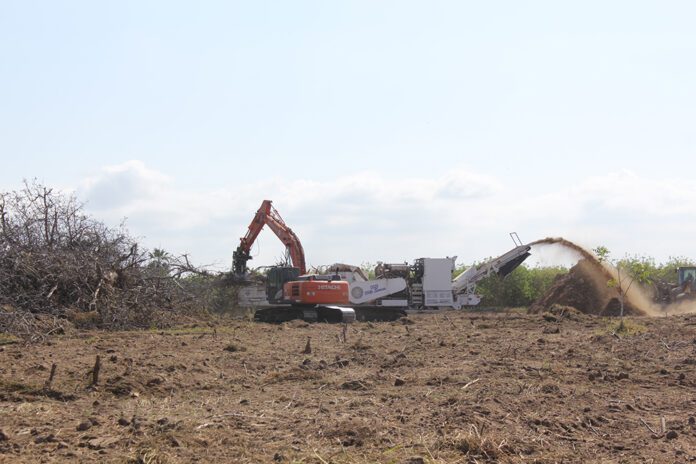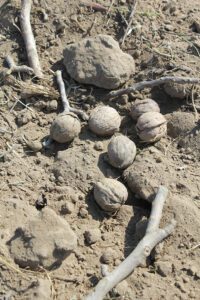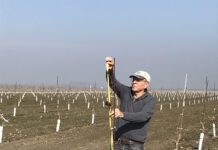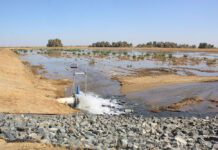
Hesitancy to replant tree nuts after an orchard removal may spark some creative uses for the ground.
Tree nut orchard removal across the Central Valley has increased in the past year for a variety of reasons: low prices, higher water costs and older trees that are no longer highly productive. In previous years, orchard sites were regularly replanted with trees as soon as feasible. Now, growers are looking at options for land use that can generate some income.
Pushing trees and removal of the biomass is stalling some replant activity due to the high cost and shortage of removal equipment. Luke Milliron, UCCE orchard advisor in Butte, Glenn and Tehama counties, noted that leads to more ‘unfarmed’ orchards which can be a source of insect and vertebrate pests as well as a potential fire hazard, making orchard management difficult for neighbors. Another option is livestock grazing where feasible. That would still require a water source and possibly fencing.
Milliron said adding a fallow year to the ground before replanting can be part of the solution both for on-farm budget reasons, improving the odds of a successful new planting, and even where Groundwater Sustainability Agency rules limit pumping.
If continuing to farm the ground is the plan, UCCE Restoration Ecologist Mandeep Riar said there are some things to consider: how the orchard was removed, if the biomass was chipped and spread or burned onsite, and residual herbicides and soil compaction.
Riar, an advisor in Kern, Kings and Tulare counties, said she has observed many whole orchard recycling operations in the past year. Any crop planted soon after the orchard has been removed, chipped and chips spread and disced into the soil will have issues due to a carbon to nitrogen imbalance. Growers will have to pay close attention that first year with annual or perennial crops and provide extra N to keep the plants growing.
Soil compaction can be an issue with annual and tree or vine crops following orchard removal. How the orchard was removed must be considered, Riar said. With whole orchard recycling, the amount of biomass can limit planting options. Riar said planting a cover crop can be one decision that will help with soil compaction but will need time to achieve full effect. N-fixing legumes can add to soil health and improve soil tilth.
A Plan for New Crop
“Leaving land fallow doesn’t pay the bills,” said farm manager Brad Shepard, standing next to a 30-acre block west of Porterville where walnut trees were being chipped.
The plan for this piece of ground, he said, is to plant kiwis, a crop that was once in the top 20 list of crops in Tulare County but has lagged in popularity in recent times.
Shepard said the chips from the walnut trees will be spread over the ground which will then be deep ripped. Discing with a slip plow will follow, and then a hand crew will be brought in to pick up any large pieces of roots that remain. Prior to planting, they will install an irrigation system and apply fungicide.
“I’m not doing my job if the kiwis aren’t planted by fall,” Shepard said.
Incorporating the chips and planting soon after will require some careful management of N. Shepard said he will be feeding more N the first year after planting until the chips break down. He added spreading and incorporating the chips back on the orchard site is the least costly option. No one has any use for the large amount of biomass that comes from a large orchard. Co-generation plant use is a thing of the past, and burning is restricted in the San Joaquin Valley.
In Tulare County, where walnut orchards are being pulled, he said, choices for annual crops are limited, mostly to winter silage for dairy feed. Permanent crops, including almonds and pistachios are the most popular choices.
Glenn County walnut grower Leslie Nerli noted the time it takes to remove and clean up pulled orchard ground gives growers a chance to think about a possible new crop investment for the long term. Right now, she said those options for payback are very limited.
Tomatoes Are One Viable Option, but Land Prep Isn’t Cheap
Patricia Lazicki, UCCE vegetable crops advisor for Yolo, Solano and Sacramento counties, reported walnut prices are driving most orchard removals in those counties. For the most part, she said almonds or pistachios are being planted following orchard removals. She did note growers, where possible, are planting a lower-value crop for the first year, mostly small grains, before going with a permanent crop.

She reported in Sacramento Valley Walnut News that some growers who were removing walnuts did choose to plant processing tomatoes. While little formal research has been done for this crop option, tomato processors have weighed in with their observations.
Cannery representatives she spoke with said they have zero tolerance for woody material in the field and in incoming loads. Large root pieces and branches slow harvest machinery, and if the wood ends up at the processor, it has the potential to damage or clog processing machinery. Labor is needed to remove roots if not allowing a transition period of one to two years (there can be issues with harvest of tomatoes.) Leftover nuts in the ground can also cause a load rejection. If detected as ‘material other than tomato,’ a big deduction for growers can be seen.
Lazicki said growers should consider another crop between the orchard removal and a tomato crop. Root removal should be a priority to ensure cleaner loads will be harvested. Other issues include preemergent herbicides that may have restrictions on plant back, making it important to check dates and products used. Nutrient tie-up has not been a problem when a field is well cleaned and the biomass removed.
She reported a large Yolo County farming operation with experience transitioning fields from walnuts to tomato warns it is an expensive undertaking, from pulling trees, to grinding and cleaning the ground. Higher yields can be achieved when the transition is done correctly.

Cecilia Parsons | Associate Editor
Cecilia Parsons has lived in the Central Valley community of Ducor since 1976, covering agriculture for numerous agricultural publications over the years. She has found and nurtured many wonderful and helpful contacts in the ag community, including the UCCE advisors, allowing for news coverage that focuses on the basics of food production.
She is always on the search for new ag topics that can help growers and processors in the San Joaquin Valley improve their bottom line.
In her free time, Cecilia rides her horse, Holly in ranch versatility shows and raises registered Shetland sheep which she exhibits at county and state fairs during the summer.















